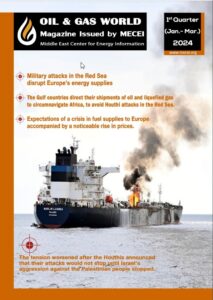- QatarEnergy selects Nakilat to own and operate 25 conventional LNG vessels
- The joint development of the Dorra field between Saudi Arabia and Kuwait is pending the demarcation of the border with Iran
- Minister of Energy reaffirms the UAE’s commitment to adopting clean energy and supporting the Paris Agreement
- The new Hassi Messaoud refinery enjoys the support of the government and President Tebboune
- Increasing electrical interconnection capacities to export electricity beyond borders
- Qatar Energy stops sending liquefied gas tankers through the Red Sea for security reasons
- The inauguration of the Duqm Refinery, the largest joint Gulf project in the refinery sector
- Saudi oil exports are faltering due to Houthi attacks on ships in the Red Sea and Gulf of Aden
- Algeria to host and chair the Gas Exporting Countries Forum summit (February 29 to March 2, 2024)
- Egypt Energy Conference and Exhibition 2024 gives a strong impetus to the global energy dialogue

10 Countries that Are Running Out of Oil

1. Colombia
Production (1,000 b/d): 1,005.6
Proven reserves (millions of barrels): 2,308
Years of production left at current level: 6 years
2015 import of crude oil (1,000 b/d): –
2015 import of petroleum products (1,000 b/d): –
Another country on our list that doesn’t import oil is Colombia. Oil exports play a significant role in country’s fiscal policy, accounting for some 20% of all exports. Almost all of the exported oil goes to the United States. As the peace deal between the government and FARC has been signed, a substantial space for increased production has been opened. Country’s rural region, previously off limit to explorers, could also hold many potential oil fields, which would hopefully increase Colombia’s energy stability. With years of production left at the current level estimated at six, Colombia is on top of this list of 10 countries that are running out of oil.
2. United Kingdom
Production (1,000 b/d): 879.7
Proven reserves (millions of barrels): 2,755
Years of production left at current level: 8 years
2015 import of crude oil (1,000 b/d): 856.2
2015 import of petroleum products (1,000 b/d): 652.4
After a short stagnation period between 2012 and 2014, United Kingdom’s oil production seems to be ramping up again. OPEC estimates that production in 2015 has been increased by more than 13% compared to 2014. With the expected start of exploitation of Mariner oilfield in 2018, the figure should remain stable, despite the depletion of oil fields currently in use. However, UK’s problems aren’t geological, but rather political. With the unexpected vote on Brexit, there are renewed clamoring for Scottish independence, which could bring up the issue of ownership of North Sea oil fields.
3. Norway
Production (1,000 b/d): 1,567.4
Proven reserves (millions of barrels): 5,139
Years of production left at current level: 8 years
2015 import of crude oil (1,000 b/d): –
2015 import of petroleum products (1,000 b/d): –
The third place on our list of 10 countries that are running out of oil goes to Norway. The smallest country on the list exports 8 times more oil and natural gas than it consumes. Unlike the other countries, Norway is actively preparing for the day when their oil runs out, investing a large part of oil income into a fund colloquially known as The Oil Fund. The fund is the largest stock owner in Europe and currently, owns 1% of all global commodities.
4. United States
Production (1,000 b/d): 9,430.8
Proven reserves (millions of barrels): 36,385
Years of production left at current level: 10 years
2015 import of crude oil (1,000 b/d): 7,351.0
2015 import of petroleum products (1,000 b/d): 2,050.0
The United States oil reserves are a somewhat controversial topic. The proven reserves of some 36 billion barrels are the highest in United States history. However, in their Statistical Review of World Energy published in June 2016, BP claims that the figure is actually 55 billion. To complicate things further, there are large reserves of oil and natural gas in Outer Continental Shelf, estimated between 66.6 and 115.1 billion barrels, which are currently off limits to oil companies due to US legislation. When all of this is put together, United States have the largest oil reserves in the world, easily surpassing those of Saudi Arabia and Russia and have no business being among the top 10 countries that are running out of oil. However, we decided to go with the OPEC and US Energy Information Administration numbers, since they represent the only proven amount
5. Mexico
Production (1,000 b/d): 2,266.8
Proven reserves (millions of barrels): 9,711
Years of production left at current level: 11 years
2015 import of crude oil (1,000 b/d): –
2015 import of petroleum products (1,000 b/d): 712.9
Mexico’s oil production is in decline and the country produced 200,000 barrels per day less in 2015 than it did in 2011. The current level of 2.2 million barrels is a far cry from 2006’s 3.7 million barrels and status of world’s seventh largest oil producer. In order to maintain productivity in one of the largest oil fields in the world, Pemex has been injecting nitrogen into the giant Cantarell Field. This massive operation was consuming half of the world’s nitrogen production at one point. The results were impressive but short-lived. The decline in oil production is causing severe fiscal problems for the Mexican government, which will require some creative thinking to solve.
6. Indonesia
Production (1,000 b/d): 690.1
Proven reserves (millions of barrels): 3,230
Years of production left at current level: 12 years
2015 import of crude oil (1,000 b/d): 374.4
2015 import of petroleum products (1,000 b/d): 506.0
Indonesia has been one of the larger oil exporters back in the 1980s, but have since then turned into a net importer, due to increased domestic consumption. It does have a significant potential for increased production, with many unexplored oil basins around the country
7. Angola
Production (1,000 b/d): 1,767.1
Proven reserves (millions of barrels): 9,524
Years of production left at current level: 14 years
2015 import of crude oil (1,000 b/d): –
2015 import of petroleum products (1,000 b/d): 134.5
Angola’s economy is heavily dependent on oil production. In 2004, 80% of the government’s budget came from oil production taxes. In the same year, the oil industry was responsible for 45% of country’s GDP. While Angola’s oil reserves are plentiful, they aren’t infinite, and some hard steps will be needed to reduce country’s dependence on the oil industry.
8. Malaysia
Production (1,000 b/d): 665.0
Proven reserves (millions of barrels): 3,750
Years of production left at current level: 14 years
2015 import of crude oil (1,000 b/d): –
2015 import of petroleum products (1,000 b/d): –
The first of only three countries on our list that doesn’t import either crude oil or petroleum products. Malaysia’s oil production is sufficient for domestic needs, with plenty remaining for exports, but when those wells dry up, some adjustment will be needed for the transition to imported oil.
9. China
Production (1,000 b/d): 4,273.7
Proven reserves (millions of barrels): 25,132
Years of production left at current level: 16 years
2015 import of crude oil (1,000 b/d): 6,730.9
2015 import of petroleum products (1,000 b/d): 1,150.9
China is slowly stepping into the role the United States played in the 1970s and 1980s, that of a glutinous oil-hungry behemoth bent on getting its oil wherever and however possible. With its domestic production peaking in 2015 and on a decline and record high crude oil imports, China is facing a strategic problem of oil dependency, one that will not be easy to solve. The recent warming up of Sino-Russian relations is aimed as a part of the solution, among other things, like an attempt to curb the American influence.
10. Brazil
Production (1,000 b/d): 2,437.3
Proven reserves (millions of barrels): 16,184
Years of production left at current level: 18 years
2015 import of crude oil (1,000 b/d): 251.7
2015 import of petroleum products (1,000 b/d): 556.6
We kick off with Brazil. South America’s largest economy needs a lot of oil to fuel its growth. Fortunately for Brazil, there’s plenty of domestic oil production to meet the demand. They do import plenty of refined fuel and even some crude oil, but overall production far outpaces the imports.
ٍSource: insidermonkey









